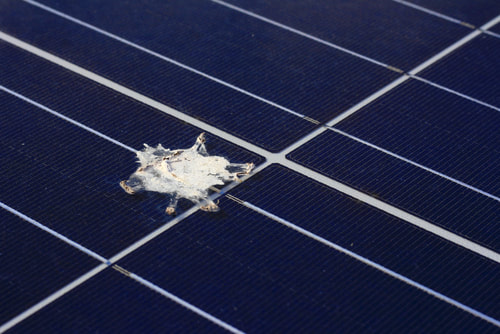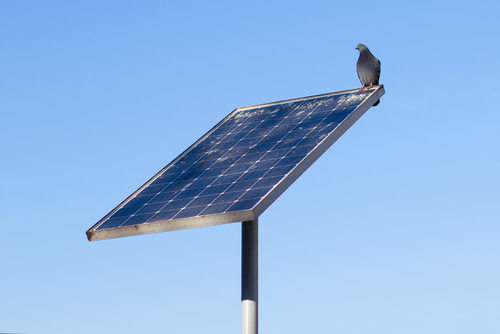|
Regular maintenance of a solar PV system will ensure it is performing at maximum efficiency and minimise the possibility of hazards – it’s just a shame not everyone does it. It might be great to harvest free electricity from your own rooftop power plant but if you want it to work properly you have to look after it. A few simple checks and some housecleaning now and then may be all that’s needed to keep a system running efficiently. In 2012 solar consultancy SunWiz looked at data from 8,000 PV systems connected to NSW network AusGrid and found the average small-scale system was performing nearly 19% below capacity, with around 18% of systems performing 20% below expectations and 7% about 40% below expectations. That was six years ago and here’s hoping things have improved since then, but system owners shouldn’t be complacent about their investment. Maintenance of a solar PV system is about so much more than cleaning the modules. “System maintenance is crucial to the ongoing optimised performance of the system – if you want it to go well, you’ve got to look after it,” says Solar Analytics technical sales account manager Brett Bidwell. The basics of maintenance include looking at the performance of the inverter and going over the solar array structure, the cabling and assessing whether anything has contributed to the system performing properly. The causes are not always related to sloppy installation standards or cheap equipment. “Over the years I’ve seen ants, termites, possums, cockatoos, rats – you name it I’ve seen it destroy a solar power system,” says Bidwell. “Cows, horses, sheep – the whole lot. I’ve seen bats roosting under arrays, all sorts of things.” Many variables that are completely unforeseen and unpredictable may impact the performance of a system, Bidwell says, so owners should understand why an annual inspection by a qualified solar installer – even it is to clean the panels – will be a good way to spot and fix issues that could become serious if left to fester. “There are opportunities there for maintenance to be discussed [with owners] very early on in the piece, even before the purchase of the system,” he says, emphasising that solar sales companies and installation companies should clearly explain the benefits of maintenance to their clients. Team effort Installers are working all hours to get systems on rooftops, with record numbers of Small-scale Technology Certificates created last year and hopefully the same again this year, so how can they be expected to find the time to go around maintaining the 1.6 million systems already in place? Simple, says Bidwell – employ more people. For a start, installers who have contractual commitments to maintain systems should manage schedules and staff especially for the purpose. “Suddenly you’ve got a crew running around doing regular maintenance,” he says. “Quite often the return on investment of those types of funding approaches is completely dependent on the optimised performance of the system, so that if it works better you get paid more.” Any good commercial and industrial solar system agreement should include a clause about operations and maintenance, Bidwell says. “It’s not an option. If it’s not there, you’re dealing with the wrong people.” At the Clean Energy Council, technical and compliance officer Luke Pickles says it’s not really incumbent on the installer to carry out maintenance – it’s up to customers to request it. “The problem is there’s a cost associated with doing maintenance and people normally buy a solar system with the purpose of saving money, so there’s a disconnect in that respect,” Pickles says. “But some companies that sell a system may include a maintenance visit as part of the sale price.” DC danger zone
The presence of rooftop DC isolators in the Australian Standard is a serious bone of contention within the installer network in Australia, Bidwell says. “Rooftop DC isolators are the single highest contributors to system underperformance or failure. DC electricity with no protection inside a plastic box that’s filled with water is not good. It will cause a problem.” The CEC’s Pickles says when a system fails it’s invariably because water has got into a DC isolator, which can also be a safety hazard. “The sooner you get on to that the better it will be.” This often is a result of a poor installation, he says, where substandard workmanship has led to little holes here and there where water can get through. “If someone drove a screw through the back of it to fix it in place, it ceases to be suitably IP protected,” Pickles says. Bidwell puts a general negligence about maintenance down to the hard sales tactics of the large installer groups, where the motivation is to sell systems, get them up and then move on. “We’ve seen the end user have a lot of information withheld or just not given,” he says. “If you buy a new car [the seller] will talk to you about maintenance and maybe even incentivise you to maintain your vehicle with them at regular intervals,” he says. “Why on earth would you not do that with the third most expensive purchase you make in your life? You don’t drive your car around until it goes clunk and then say, ‘Maybe I should have put some oil in it.’” As a representative of solar PV monitoring software company SolarAnalytics, Bidwell reminds EcoGeneration that performance monitoring systems will alert system owners to problems, if owners are prepared to pay a little extra. “The optimised performance of any system is down to the movement of data and the collection and analysis of data,” he says. “If you can do that remotely you can optimise the performance of a number of systems.” Something’s not right… Owners will be the first ones to know their system is underperforming, but only if they’re paying attention. First, the owner can check the output of the system via monitoring or the inverter, which will tell them how much energy it’s produced over various defined periods. This data can be compared with the system performance estimate the customer will have received from the installer. “They should line those two things up,” says Pickles. “If they’re told it’s going to produce, say, 20kWh a day they can check on the unit to see if that’s actually happening.” For many owners the first sign something’s wrong is when their electricity bill jumps. Such was the case with Pickles’ mother’s installation in Queensland, where she only twigged there was something wrong with her solar system when her electricity bill increased “by a lot”. Sure enough it turned out the inverter had failed. “She’s not out there every day checking it’s working but she is checking her bill when it’s time to pay,” Pickles says. Panels are easy to clean but owners shouldn’t think of getting up on roofs and doing the job themselves, he says – most window-cleaning companies will do the work. In general the CEC says washing dirty or dusty arrays will boost production by about 5%. “It depends on your location,” he says. “If it’s very dusty or you’ve got a problem with bird droppings it can be substantial.” Only if it’s worth it Although soiling does have an impact on the efficiency of PV installations, the cost of cleaning needs to be lower than the regained panel efficiency for it to be worth doing. Owners of large-scale systems have a lot of money on the line and won’t tolerate flagging yields, so they use formulas to work out what additional energy they’ll get versus the cost of operational maintenance. For the past couple of years NSW company SolarClear has been working on a cleaning system that clips onto panels and simulates a rain shower of between three and four minutes’ duration. Large systems in arid zones would be a key target, says marketing director Andrew Petersen, who estimates about 40% of Australian residential systems are located in parts of the country where regular cleaning would be advised. Petersen says developers of some Australian solar plants he’s spoken with claim they accept some loss of efficiency from soiling as a fact of life, hopeful that rain will clean systems for them. In other parts of the world, however, such as the sandy Middle East, some owners of plants have installed low-tech cleaning technology akin to rollers in a car wash, but waterless, and in regions where labour is very cheap workers are employed to wash arrays. “There are robot technologies for the solar farm level but there is nothing on a domestic level,” he says. A couple of international studies have shown the importance of cleaning systems in desert locations: a system in Doha, the capital of Qatar, was 3.7% more efficient the day following cleaning (after accounting for the difference in solar irradiance levels the day before); and a laboratory study that aimed to simulate conditions for a system in the Algerian desert found that energy output dropped in line with the level of soiling, with loss of 180MWh a year for a 1MW plant.
3 Comments
2/6/2023 09:36:20 pm
It helped when you mentioned that a simple visual inspection could help prevent problems for your solar system. My uncle mentioned last night that he was looking for a maintenance solution that could help ensure the proper function of their solar farm system. He asked if I had any idea what would be the best option to ensure proper servicing. Thanks to this informative article, I'll tell him it will be much better if they consult a trusted solar farm maintenance service for more information about the maintenance process.
Reply
Leave a Reply. |
|



 RSS Feed
RSS Feed


